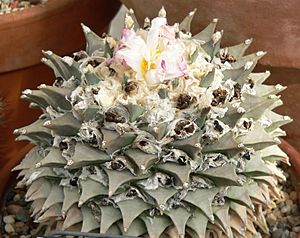Ariocarpus retusus facts for kids
Quick facts for kids Ariocarpus retusus |
|
|---|---|
 |
|
| Conservation status | |
| Scientific classification | |
| Genus: |
Ariocarpus
|
| Species: |
retusus
|
Ariocarpus retusus is a unique type of cactus. It belongs to the Ariocarpus family. You can mostly find this special plant growing in Mexico. It's known for being one of the biggest and fastest-growing cacti in its group, even though it still grows quite slowly compared to other plants.
Contents
About the Ariocarpus retusus Cactus
Ariocarpus retusus is a fascinating plant. It is a type of cactus that looks quite different from what you might expect. Instead of tall, spiky stems, it has a flat, often star-shaped body. This cactus grows very slowly. It can take about ten years for it to grow big enough to produce its first flowers.
What Makes it Special?
Even though it grows slowly, Ariocarpus retusus is very popular among plant lovers. People like to grow it because it has beautiful flowers. Its unusual shape also makes it stand out from other cacti. It's one of the easiest types of Ariocarpus cacti to care for.
An Unusual Look
Unlike many cacti, Ariocarpus retusus does not have sharp spines. Instead, it has bumpy, triangular parts called tubercles. These tubercles are arranged in a spiral pattern. They give the cactus a unique, almost rock-like appearance. This helps it blend in with its surroundings in the desert.
Beautiful Blooms
When it flowers, usually in the fall, Ariocarpus retusus produces lovely blooms. These flowers can be white, pink, or yellow. They often appear right from the center of the plant. The flowers are a beautiful contrast to the plant's tough, grey-green body.
Where Does it Grow?
Ariocarpus retusus is native to Mexico. It grows in dry, rocky areas. These areas are often found in deserts or semi-desert regions. The cactus is very good at surviving in these harsh conditions. It stores water in its thick body to last through dry periods.
Natural Habitat
This cactus prefers to grow in limestone soils. It often hides among rocks or under shrubs. This helps protect it from the intense sun. It also helps keep it safe from animals that might want to eat it. Its natural home is a tough environment, but Ariocarpus retusus is well-adapted to it.
See also
 In Spanish: Ariocarpus retusus para niños
In Spanish: Ariocarpus retusus para niños



